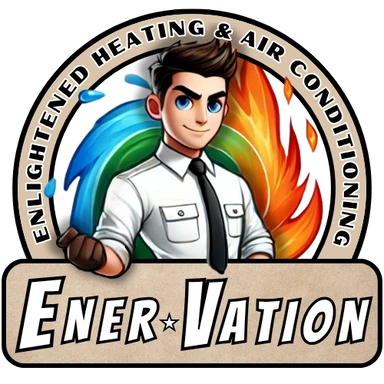Don't Overlook These 5 Critical HVAC Warning Signs
Your home’s HVAC system is a complex network designed to keep you comfortable year-round. While it often works silently in the background, it’s not immune to problems. Ignoring the subtle hints your system provides can lead to costly repairs, decreased efficiency, and even potential safety hazards. Recognizing these warning signs early is crucial for maintaining a healthy and comfortable indoor environment. Enervation HVAC understands the intricacies of these systems and wants to equip homeowners with the knowledge to identify when professional intervention is necessary.
Five Critical HVAC Warning Signs You Should Never Ignore
Strange Noises Emanating from Your System
An HVAC system typically operates with a low hum or the gentle whoosh of air. Any departure from these normal sounds warrants attention.
- Banging or Clanking: Often indicates loose or broken parts within the outdoor unit or air handler, such as a motor bearing going bad or a fan blade hitting something. Ignoring this can lead to further damage to internal components.
- Squealing or Grinding: This usually points to issues with the motor bearings, belts, or other moving parts that are worn out and need lubrication or replacement.
- Hissing or Bubbling: These sounds can be a strong indicator of a refrigerant leak. Refrigerant is essential for your system’s cooling capabilities, and leaks can reduce efficiency, damage the compressor, and are harmful to the environment.
- Clicking (excessive or unusual): While some clicking is normal during startup and shutdown, persistent or loud clicking could signal a failing relay, a malfunctioning thermostat, or an electrical issue.
Ignoring unusual noises can escalate minor issues into major system failures, potentially requiring extensive repairs or even premature replacement.
Inconsistent or Uneven Temperatures Throughout Your Home
Is one room an icebox while another feels like a sauna? Inconsistent temperatures across different areas of your home are a common and frustrating warning sign. This indicates that your HVAC system isn’t distributing conditioned air effectively or isn’t maintaining a consistent temperature set point.
- Potential Causes: This can stem from several issues, including a faulty thermostat, clogged air filters restricting airflow, leaky or poorly insulated ductwork allowing conditioned air to escape, or even an imbalanced refrigerant level. Zoning problems or a dying blower motor can also contribute.
- Risks: Beyond just discomfort, uneven temperatures mean your system is likely working harder than it should to compensate, leading to higher energy bills and increased wear and tear on components. It also suggests that certain areas might not be getting enough conditioned air, potentially leading to humidity issues or mold growth in warmer, stagnant spots.
Unusual or Foul Odors Emitting from Vents
The air coming from your vents should ideally be odorless. Any strange smells are a clear sign that something is amiss within your HVAC system or ductwork.
- Burning Smell: This is often a critical sign, potentially indicating an electrical problem, an overheated motor, or wiring issues. Do not ignore a burning odor, as it can pose a fire risk.
- Musty or Moldy Smell: This is a classic indicator of moisture buildup and mold or mildew growth within your evaporator coil, drain pan, or ductwork. Inhaling mold spores can lead to respiratory issues and allergic reactions.
- Dirty Sock Smell: This particular musty odor is often attributed to bacteria growth on the evaporator coil, especially common in humid climates.
- Foul, Rotten Egg Smell: This could indicate a gas leak from a gas-fired furnace or a deceased animal trapped in the ductwork. Gas leaks are extremely dangerous and require immediate attention.
Promptly addressing these odors is not just about comfort; it's often about safeguarding your health and home.
Noticeable Increase in Your Energy Bills
One of the most insidious warning signs is a sudden and unexplained spike in your monthly energy bills, especially if your usage habits haven't changed. This typically means your HVAC system is losing efficiency and consuming more energy to achieve the desired temperature.
- Common Culprits: A dirty air filter is a frequent offender, as it restricts airflow and forces the system to work harder. Other causes include refrigerant leaks, a failing compressor, leaky ductwork, uncalibrated thermostats, or an aging system nearing the end of its lifespan.
- The Hidden Cost: While higher bills are an immediate concern, the underlying inefficiency also puts added strain on your system’s components, accelerating wear and tear and potentially leading to more expensive breakdowns down the line. It's a sign that your system is no longer operating optimally and is struggling to keep up.
Visible Signs of Physical Damage or Malfunction
Sometimes, the warning signs are right before your eyes. Physical damage or visible malfunctions should never be overlooked.
- Water Leaks Around Your Unit: Puddles or drips around your indoor or outdoor unit can indicate a clogged condensate drain line, a cracked drain pan, or a refrigerant leak (which can also cause ice formation). Water leaks can lead to significant property damage, electrical hazards, and mold growth.
- Ice Formation on the Refrigerant Lines or Coils: Ice on your AC’s outdoor lines or indoor evaporator coil is a strong indicator of a problem, most commonly restricted airflow (due to a dirty filter or blocked vents), low refrigerant levels, or a malfunctioning fan. An iced-over coil cannot absorb heat effectively, leading to poor cooling and potential compressor damage.
- Corrosion or Rust on Components: Visible rust or corrosion on parts of your system, especially on electrical terminals or the drain pan, indicates prolonged moisture exposure or a chemical reaction. This can compromise the structural integrity and electrical functionality of the system.
These visible cues are urgent calls for attention, as they often precede major component failures if left unaddressed.
When to Call the Professionals
While changing an air filter or checking your thermostat batteries are simple DIY tasks, most of the warning signs listed above require the expertise of a trained HVAC technician. Attempting complex repairs without proper knowledge and tools can lead to further damage, void warranties, and potentially create unsafe conditions.
Regular professional maintenance is the best defense against many of these issues, as technicians can identify and address potential problems before they escalate. If you notice any of these signs, don't wait for a complete system breakdown. Early diagnosis and repair can save you money, extend your system's life, and restore your home's comfort and safety.
Recognizing these five HVAC warning signs is the first step toward preventing larger, more expensive problems. If your system is exhibiting any of these symptoms, taking prompt action is key.
Schedule Your HVAC Diagnostic with Enervation HVAC
Ignoring critical HVAC warning signs can compromise your home’s comfort, safety, and budget. If you've noticed any of these issues, the skilled technicians at Enervation HVAC are ready to deliver comprehensive air conditioning, heating, indoor air quality, and ductless services. We are committed to restoring your system’s efficiency, enhancing your indoor environment, and ensuring your peace of mind. Contact us today to schedule your service and let us help keep your home comfortable, healthy, and safe.
Customer Testimonials
Our customers consistently praise the quality and reliability of our products, highlighting their satisfaction in numerous reviews.



